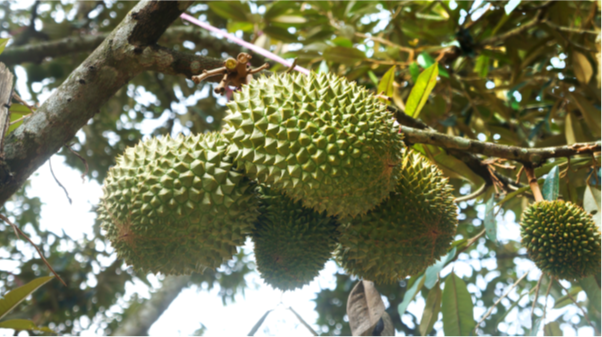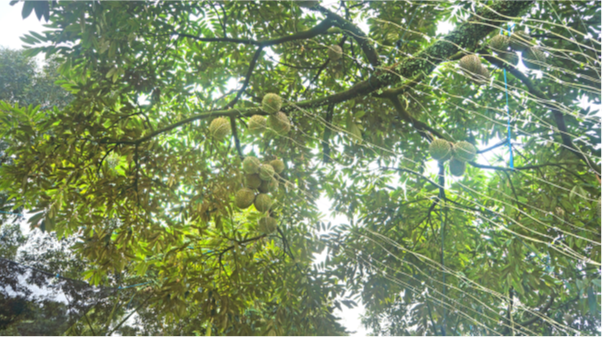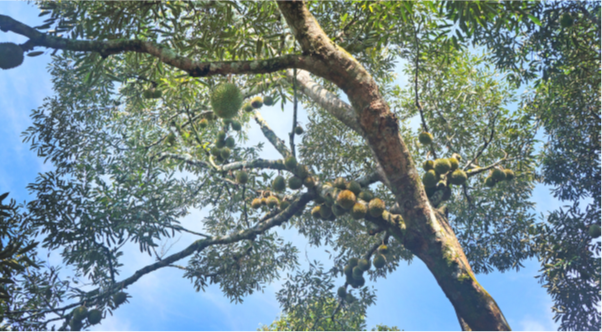Articles
Durian: Beware The 'Problem' Nutrients During Fruit Development
Fertiliser specialist Agrobridge is continuing its campaign to help the region’s durian producers improve the yield and quality of their harvest as the crop enters the crucial fruiting stage, by taking action to deal with two elements widely recognized as ‘problem’ nutrients.
Both calcium (Ca) and potassium (K) are vital macronutrients for durian, influencing fruit size and shape and, in the case of calcium, playing an important role in the ripening process. But failure to manage levels of these essential nutritional components can lead to disappointing results at harvest.
Small, poorly shaped fruits, with watery flesh, are common in trees that have not received an optimized nutritional regime. But by ensuring durians to access sufficient calcium and potassium during the fruit growth and development stage, growers not only maximize their orchards’ overall yield potential but also increase their marketable yield – the proportion of harvested fruit that can be sold.
Calcium has always been regarded as a ‘problem’ nutrient by plant physiologists, says Agrobridge–and the problem isn’t limited to durian. Ripening and developmental problems across a range of fruits – for example, apples exhibit the classic ‘bitter pit’ syndrome, while calcium-poor strawberries and blueberries soften rapidly after harvest – have related to insufficient levels or poor management of this important macronutrient.
The main issue, Agrobridge points out, is that most plants can’t store calcium, nor are they able to move it around between roots, leaves, and fruit. Even in calcium-rich soils, plants can often struggle to absorb and use enough calcium to meet their needs.
So proper timing of calcium supplementation is essential and, according to Agrobridge, this is the time at which growers should consider foliar applications of a product such as Wuxal Calcium Foliar – a calcium-rich supplement co-formulated with several essential trace elements. While no demonstrable link has yet been established between the three most common durian fruit problems – uneven fruit ripening, wet core, and tip burn – and lack of calcium, all are understood to be exacerbated by unfavorable conditions, such as water or nutrient availability.

Even in the absence of wet core, increasing the availability of potassium
should provide a recognizable return on investment.
The picture may be clearer with a wet core, however. This condition, which sees the fruit centre and its flesh become very moist and soft, has been associated with heavy rain just before harvesting. Other evidence points to heightened susceptibility for trees growing in soil that has low levels of potassium. As potassium is known to affect the levels of fruit solids, the connection is logical if not yet proven.

Potassium, a nutrient that’s known to influence fruit size and which is necessary to maintain
sugar levels within the fruit.
Agrobridge says growers who have previously experienced wet core should consider a potassium supplement such as Wuxal K40. But even in the absence of wet core, increasing availability of potassium – a nutrient that’s known to influence fruit size and which is necessary to maintain sugar levels within the fruit – should provide a recognisable return on investment.
One further nutrient – this time a trace element – that Agrobridge advises growers to consider is boron. Many growers might already have made a foliar application of boron during the tree’s flowering stage, where its main role is in pollen germination and creation of pollen tubes – but its influence continues into fruit development, too.
Another nutrient that’s connected with auxin, adequate boron levels are necessary to ensure uniform fruit size and even ripening. Both Wuxal Calcium and Complex Purple Special are co-formulated with boron.

As ever, Agrobridge suggests growers turn to foliar applications for the best agronomic effect – and repeats its 5 Golden Rules:
- Treat foliar fertilization as a supplement for a granular fertilizer, not a replacement
- Follow the instructions for dilution very carefully, using only clean and clear water
- Check the weather forecast and apply at the right time – not when it’s windy if rain is forecast, or in full sunlight
- Consider using an adjuvant – a spray additive that helps the product ‘stick’ to the leaf and works more efficiently. Wuxal products already contain these.
- If appropriate (check labels or ask), combine a foliar fertilize with an insecticide or fungicide to reduce costs of the application. Wuxal products have been tested for compatibility with a range of different pesticides, but it’s always advisable to check.












